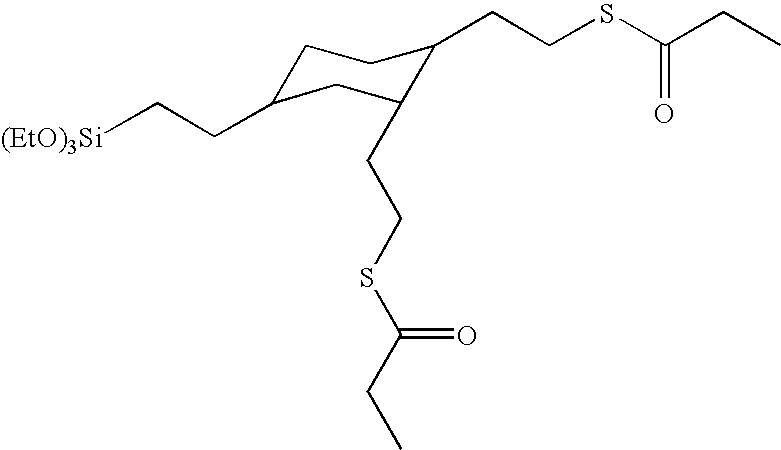Blocked mercaptosilane coupling agents, process for making and uses in rubber
- Summary
- Abstract
- Description
- Claims
- Application Information
AI Technical Summary
Benefits of technology
Problems solved by technology
Method used
Image
Examples
example 1
Preparation of (2-triethoxysilylethyl)-bis-(3-thia-4-oxohexyl)cyclohexane
[0125]This example illustrates the preparation of a thiocarboxylate alkoxysilane from a silane containing two vinyl groups through the formation of an intermediate thioacetate silane.
[0126]The preparation of the (2-trimethoxysilylethyl)divinylcyclohexane was prepared by hydrosilation. Into a 5 L, three-neck round bottomed flask equipped with magnetic stir bar, temperature probe / controller, heating mantle, addition funnel, condenser, and air inlet were charged trivinylcyclohexane (2,001.1 grams, 12.3 moles) and VCAT catalysts (1.96 grams, 0.01534 gram platinium). Air was bubbled into the vinyl silane by means of the air inlet where the tube was below the surface of the silane. The reaction mixture was heated to 110° C. and the trimethoxysilane (1,204 grams, 9.9 moles) was added over a 3.5 hour period. The temperature of the reaction mixture increased to a maximum value of 130° C. The reaction mixture was cooled ...
example 2 and 3
The Use of Silanes in Low Rolling Resistant Tire Tread Formulation
[0132]A model low rolling resistance passenger tire tread formulation as described in Table 1 and a mix procedure were used to evaluate representative examples of the silanes of the present invention. The silane in Example 1 was mixed as follows in a “B” BANBURY® (Farrell Corp.) mixer with a 103 cu. in. (1690 cc) chamber volume. The mixing of the rubber was done in two steps. The mixer was turned on with the mixer at 80 rpm and the cooling water at 71° C. The rubber polymers were added to the mixer and ram down mixed for 30 seconds. The silica and the other ingredients in Masterbatch 1 of Table 1 except for the silane and the oils were added to the mixer and ram down mixed for 60 seconds. The mixer speed was reduced to 35 rpm and then the silane and oils of the Materbatch 1 were added to the mixer and ram down for 60 seconds. The mixer throat was dusted down and the ingredients ram down mixed until the temperature rea...
examples 4 and 5
[0138]The rubber compounds described in Table 2 were prepared according to the procedures of Examples 2 and 3. The data from Table 2 show and improve in the delta rebound over the two comparative Example D and E.
TABLE 2Example NumberExampleExampleIngredientsUnitsComp. DComp. E4.005.00Masterbatch 1SMR-10, natural rubberphr10.0010.0010.0010.00Budene 1207, polybutadienephr35.0035.0035.0035.00Buna VSL 5025-1, oil-ext. sSBRphr75.6375.6375.6375.63N339, carbon blackphr12.0012.0012.0012.00Ultrasil VN3 GR, silicaphr85.0085.0085.0085.00Sundex 8125TN, process oil.phr6.376.376.376.37Erucical H102, rapeseed oilphr5.005.005.005.00Flexzone 7P, antiozonantphr2.002.002.002.00TMQphr2.002.002.002.00Sunproof Improved, waxphr2.502.502.502.50Kadox 720 C, zinc oxidephr——2.50—Industrene R, stearic acidphr——1.00—Aktiplast ST, disperserphr4.004.004.004.00Silane TESPDphr4.50———Silane Comparative Example 1phr—6.90——Silane Example 2phr——9.689.68TMPphr————Masterbatch 2Kadox 720 C, zinc oxidephr2.502.50—2.50Indus...
PUM
| Property | Measurement | Unit |
|---|---|---|
| Temperature | aaaaa | aaaaa |
| Temperature | aaaaa | aaaaa |
| Temperature | aaaaa | aaaaa |
Abstract
Description
Claims
Application Information
 Login to View More
Login to View More - R&D
- Intellectual Property
- Life Sciences
- Materials
- Tech Scout
- Unparalleled Data Quality
- Higher Quality Content
- 60% Fewer Hallucinations
Browse by: Latest US Patents, China's latest patents, Technical Efficacy Thesaurus, Application Domain, Technology Topic, Popular Technical Reports.
© 2025 PatSnap. All rights reserved.Legal|Privacy policy|Modern Slavery Act Transparency Statement|Sitemap|About US| Contact US: help@patsnap.com

